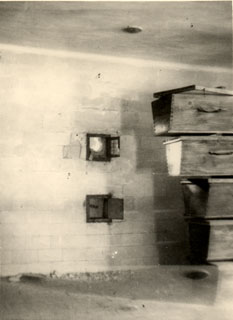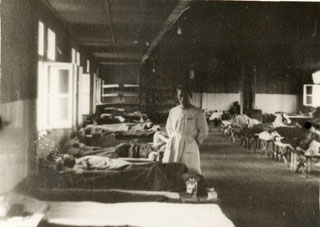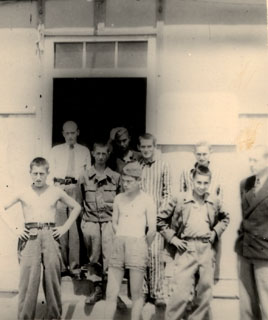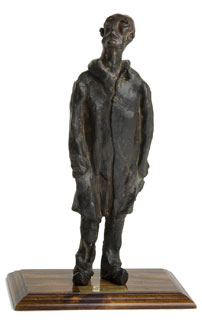Dr. Reuben Berman: At Dachau
Dr. Reuben Berman of Minneapolis was drafted into the Army Air Corps in July of 1941. He was stationed in Britain from 1942 until the spring of 1945, when he was sent to France and Germany, where he had the assignment of investigating German medical research installations. Dr. Berman arrived at Dachau concentration camp three weeks after its liberation by American forces. He barely touched on the horrors he saw there in his letters to his wife, Isabel, and his children back in Minnesota, but recorded his observations in an official report in which he described in detail the camp, the methods of torture used, and research experiments conducted on prisoners of war.
Report Transcript
ANNEX "H", 30 May 1945
Subject: Field Trip to Dachau concentration Camp (SS Koncentrationlager)
To: A-2, Hq 2nd Air Disarmament Wing (Prov), APO 149. Copy to Aero-Medical Intelligence Officer, Disarm Div, Hq IX AFSC.
1. The Dachau Concentration Camp visited with Lt. Col. J.F. Tilden, M.C. May 27, 1945 for the purpose of investigating research of interest of Aviation Medicine.
2. General Description. The camp consists of a great number of one story building scattered over an area of approximately two (2) square miles on the northern edge of town of Dachau. The core of the installation consists of a series of some sixty (60) barrack buildings lined up in 2 rows inside of a fenced-in area about 150 yards square. The fence was electrically charged. Each building should house about one hundred (100) troops by American standards. With the use of four (4) tiered bunks each housed 1200 to 1500 prisoners. This inner compound also contained a hospital to be described later, a kitchen, bath house, solitary cells and crematorium. This area is surrounded by buildings used by German troops, SS guards, Administrative personnel and, at times for prisoners.
3. Description of Methods of Torture and Devices for Murder. The methods were described by a Polish English speaking guide who had been a prisoner at Dachau for over two (2) years.
a. Solitary cells. Cubicles were set up inside of prisoner cells; 6 cubicles to a cell, each the size of an ordinary telephone booth. These were provided with straps to hold the victim in an upright position. The torture consisted of maintaining the person in an upright position in such a chamber for a period of 24 to 48 hours. Remnants of whips were found in these solitary confinement cells. The whips consisted of an iron spring core covered with rubber and tipped with lead.
b. Hanging by the arms. The victim's wrists were tied behind him and he was hung by the arms to a beam near the ceiling for a period of 45 minutes to 2 hours.
c. Starvation. The condition of the prisoners indicated that insufficient diet was given to practically all the inmates. Nearly all the prisoners were emaciated. The hospital cases all had at least three (3) diagnoses: 1st, malnutrition; 2nd, avitaminosis; and 3rd, whatever else was wrong with the patient.
d. The Gas Chamber. This room measured about 15 x 15 feet with a door leading to the crematorium. The ceiling was studded with what appeared to be shower heads. These were perforated disks set in the ceiling but were attached to no plumbing. In the floor were grills for the admission of gas. There was an observation window in one wall. The victims were told to undress and were told they were to get a bath. They were given towels and sent into the gas chamber. Cyanide gas was admitted through the grills below and when the victims were unconscious or dead the room was ventilated and bodies delivered to the adjacent crematorium. The apparent purpose of the shower bath humbug was to make the task of getting the victims into the gas chamber easier and in a properly unclothed state. Using this subterfuge the victims cooperated in their slaughter.
e. Individual execution yards. A few yards from the crematorium was a sand bank arranged for individual execution on either side. The victim knelt beside the sand bank and was shot in the back of the head with a pistol.
f. Mass execution yard. Adjacent to the sand bank there was a ditch measuring 2 x 30 feet covered with a grill. The victims lined up on their knees in front of the grill with their heads over the ditch and were shot in the back of the head. The ditch served the purpose of collecting the blood.
g. The crematorium. The crematorium was in the same building as the gas chamber. It consisted of 3 ovens, each about two (2) feet square and seven (7) feet deep, built to accommodate two (2) bodies. The crematorium was ideally located immediate adjacent to the gas chamber and only a few yards from the shooting yards to reduce the labor of transporting bodies to a minimum. It is evident that the abbatoir practice of moving animals under their own power as much as possible was followed to the limit. A room adjacent to the crematorium served as a morgue. At the time of our visit a 6 x 6 truckload of bodies, approximately forty (40), had just been piled on the floor two (2) deep in the morgue.
4. The inner compound hospital. The hospital in the inner compound occupied approximately four (4) buildings. Using the triple decking there were beds for about 1800 patients. A Polish physician, Dr. Bruno Fiskolski, is in charge under direction of the American Army. The hospital has an outpatient department, dental set-up with four (4) chairs (looted from Poland) and well equipped operating rooms for septic and clean cases. At the time of our visit there were approximately seven hundred (700) cases of typhus fever in the hospital. The death rate is 8%. Other infectious diseases of importance are diptheria, tuberculosis and scarlet fever.
5. Aero_Medical Research. According to Dr. Fiakolski research in immersion and explosive decompression were conducted from 1941 to March 1944. Most of the records were destroyed. A few remaining records of these experiments and experiments in malaria were gathered up previously by an American medical colonel whose name is not known. These records according to Dr. Fiakolski are to be returned May 29 and will be sought for on my next visit. All the equipment such as immersion tanks and low pressure chambers were removed or destroyed in 1944.
a. Explosive decompression. Dr. Fiakolski knew very little about these experiments. He stated that his information came mainly from autopsies of subjects of experiments. Bodies subjected to such experiments were found to have congestion of cerebral vessels with capillary hemorrhages, and engorged spleens. None of the victims of these experiments survived.
b. Experiments on Immersion. This information was obtained from Dr. Fiakolski and by reading the statements of victims used for the experiments. A statement of a Catholic priest, Siedza Michalowskiege, in Polish, and two (2) other statements of victims are appended. The subjects were dressed in Luftwaffe clothing and immersed in tanks of water cooled with floating cakes of ice. The mouth temperature was taken and in the case of the Catholic priest he remembers it got down to 30º C. At that point he lost consciousness. ...There are many survivors of these experiments still present at Dachau and several of these will be interviewed at another visit.
REUBEN BERMAN, Major, M.C., Surgeon





Source
Berman, Dr. Reuben, Reuben Berman and Family Papers, 1943-1945. Minnesota Historical Society Manuscripts Collection.
Berman, Ruth, Compiler; Judy Barrett Litoff, Editor, Dear Poppa: The World War II Berman Family Letters. St. Paul: Minnesota Historical Society Press, 1997.
Dachau. United States Holocaust Memorial Museum, 2007.


